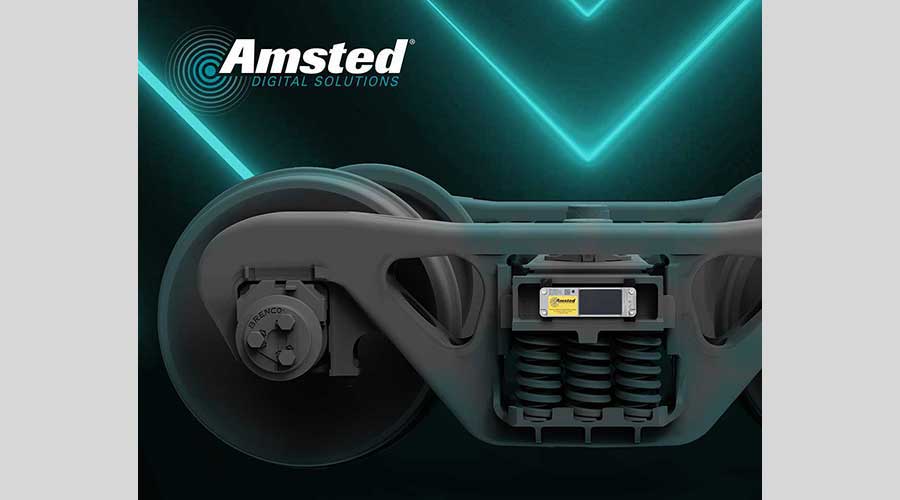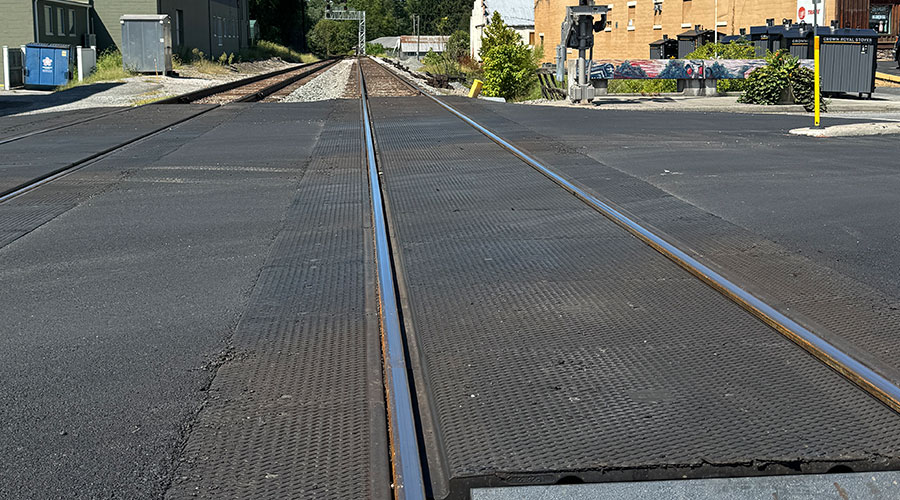Stay updated on news, articles and information for the rail industry
July 2012
Rail News: C&S
Asset monitoring systems give railroads, shippers the information they want
By Julie Sneider, Assistant Editor
Given the way technology has evolved, railroads and rail shippers now expect to know the condition of their rail cars, precisely where they are and when they will arrive at their destination.
And, given the way technology continues to evolve, companies that provide asset-tracking devices, equipment and systems are striving to come up with better ways to help customers get the asset information they want — and get a better bang for their monitoring buck.
"If you are going to receive a shipment by rail, whatever it might be, the customers' customer that's receiving that product is expecting a higher level of service, more timely information, better information on how that shipment is coming to them and in what condition it's coming to them," says David Baker, president of Lat-Lon L.L.C., which provides remote asset tracking and monitoring equipment.
Specifically, the company offers wireless GPS tracking units, intelligent monitoring sensors and accessible reporting tools to provide real-time shipment information by way of computer or mobile device.
Customers can use Lat-Lon sensors to monitor cars for critical events such as hand-brake application, a security breach, hot bearing, load temperature and over-speed impact. The devices also can be used to track when a car was loaded, when it left the plant, when it arrived to the customer and when the car was returned.
tapping solar energy
Lat-Lon also offers a self-charging, solar-powered tracking unit (STU), which can be installed on the outside of a rail car with a magnetic mount or a few bolts. In June, Lat-Lon was recognized for its STU when it received the "Gold Value Chain Award in Fleet Management" from Connected World Magazine.
"We've chosen to use solar panels for our power supply — and that's one of many pieces to the power system — but the key point is that every day our unit is getting a fresh batch of energy to do things with," Baker says. "With that extra power comes extra capability, and the main use of that extra power is to . . . do more frequent updating of information."
A new growth area for the company is the development of remote sensors that can be deployed throughout the rail car.
"So imagine on an auto rack, if you have an impact, there not only is the question of what did the rail car experience, but also the question of what did the automobiles experience," says Baker. "All the different dynamics that could happen in the car that would affect the health of the car or the well-being of the payload are things that we're moving into in the future."
Also pushing the technology envelope is Amsted Rail's IONX L.L.C., which develops ultra-low power, wireless telematics solutions that provide GPS tracking, asset status and condition monitoring for rail cars and locomotives. Product lines include the IONX Edge™ and IONX Connect™ systems, which consist of a communication management unit (CMU) that integrates optional wireless sensors as well as a Web interface to monitor and track assets.
IONX's CMU is a self-contained cellular, satellite or dual-mode communication processor installed on a car or locomotive to alert customers to situations or activities that could impact the assets. The website and data feeds interface with enterprise resource planning systems, such as SAP AG, enabling customers to access and analyze incoming data from the units, IONX officials say. The optional sensors can detect an impact, load temperature, hand-brake and other situations.
IONX can communicate with and reprogram the CMU over the air, which allows the firm to add enhancements to the unit and change settings on the wireless sensor nodes, says IONX Managing Director and Chief Technology Officer William LeFebvre.
"So, if we wanted to change a threshold setting on, say, the temperature alert, we can actually cascade it right down to the sensor itself, and it will alert the CMU when it's seeing a temperature threshold exceeding," he says. "I would sum it up as a lot more intelligence being driven down to the freight car."
The company's newest product line is the Edge T-Series, a cellular-based device that can provide benefits to a variety of assets. IONX officials describe the T-Series as "an intrinsically safe, high performance device that requires very little power."
It combines GPS technology with proven robust wireless sensor systems, and has logic so that it can send standard scheduled messages, as well as run autonomously to send event-based messages. The features give customers flexibility in designing a system to meet their specific needs, IONX officicals say. In addition, onboard geo-fences give users timely alerts to help with just-in-time operations.
TransCore recently introduced its next generation of products for rail and intermodal asset tracking and management: the new Multiprotocol Rail Reader (MPRR) and a field-processing unit called the Train Recording Unit (TRU). The TRU captures automatic equipment identification (AEI) tag data to report an accurate train consist to railroad management systems, according to TransCore officials.
TransCore's new Multiprotocol Rail Reader uses digital technology, combines the reader card and radio frequency module into one case, and can run up to four antennas, says Clint Duncan, TransCore's general manager, vice president RFID asset tracking products.
Customers desire flexibility
The more powerful reader also offers more flexibility, improves reader performance at higher train speeds and interfaces with the TRU rail wayside AEI system. Railroads can use the system to manage their rail cars' location, load status, maintenance status and underutilized assets, such as empty cars sitting in rail yards.
"Customers have been very excited about being able to penetrate deeper into their yards to keep up with their rail cars so that they aren't dwelling so long and aren't underutilized, which takes their capital investments to a whole new level," Duncan says. "If I can utilize my car three times a month as opposed to once a month, you can imagine the savings on having to purchase or lease new cars."
The TRU can handle information from both single- and multi-track locations, a feature customers have been wanting for some time, he says.
"This new TRU is like going from a Model T to a current Ferrari," Duncan says.
Of course, there are occasions when rail cars need repairs. That reality has contributed to an expanding market for software and analytics provider RMI, a GE Transportation company, through its rail car repair billing and rail car maintenance management software platform known as ExpressYard.
"We have over 65 percent of repair car shops on that product in the United States and North America, and that's a very fast growing market for us," says Kirk Knauff, RMI's senior vice president of marketing and services. "We are working with large car repair organizations right now; that product will continue to grow rapidly for us."
The company's "flagship" product remains RailConnect, a software system that provides core transportation management functions, including rail operations control, revenue settlement and management of car-hire accounting. More than 450 railroads use the system, which is designed to help railroads improve productivity and reduce costs, Knauff says.
In response to the trend toward all things mobile, RMI offers the RailConnect mCrew, which puts the company's TMS application "directly in the hands of the train crew to manage, record and report car movements in the field," according to a description on RMI's website.
On the shipper side, RMI offers ShipperConnect, which provides industrial rail shippers with software products that help them manage their rail operations, process inventory and control their rail-car assets.
The ShipperConnect Yard Management product takes feeds from AEI readers to manage and process rail cars in the yard; and the ShipperConnect Rail Track & Trace provides estimated times of arrival, fleet sizing, and asset management information to meet customers' goals.
Another technology provider — Industrial Networks Ltd. — has served shippers for years by deploying a secure, wireless network for data collection of RFID, AEI and barcode tags. The company offers a portable and stationary scanner product line for shippers under the YardMaster® name. Shippers represent about 95 percent of the company's customer base, says Jackson Dawson, director of sales and marketing.
The company also serves short lines and regionals with portable and stationary scanners under the RAILTRAC® name. Soon, the company will start serving Class Is, offering an Internet-protocol-based mainline reader called INetRAIL®, says Dawson.
The INetRAIL system will "capture AEI tag data to report an accurate consist to any railroad management system," according to a product brochure. The information collected can be transmitted to multiple host computer systems.
In May, the company displayed the new reader at the Railway System Suppliers Inc.'s 2012 conference, where the product received a "very positive response" from potential customers, Dawson says.
Smart phones affect demand
Meanwhile, the company's handheld readers have been gaining popularity as the general population becomes more adept at using smart phones and computer tablets, Dawson says.
"Even in the past five or six years, my sales in handhelds to shippers have gone through the roof because everyone is a lot more comfortable using the iPhone now," he says. "And that has helped some of the vendors get a lot more aggressive with their technology."
Other technology providers concur.
"There is an adoption rate that is taking place now that is going up that exponential curve," says Lat-Lon's Baker. "We've already shipped [this year] more than everything we sold last year, so we are up about 300 to 400 percent in our sales rate this year over last year. That's because this technology has been recognized as being mature and ready, and the way you do business now."


 2025 MOW Spending Report: Passenger-rail programs
2025 MOW Spending Report: Passenger-rail programs
 Gardner steps down as Amtrak CEO
Gardner steps down as Amtrak CEO
 Guest comment: Oliver Wyman’s David Hunt
Guest comment: Oliver Wyman’s David Hunt
 Women of Influence in Rail eBook
Women of Influence in Rail eBook
 railPrime
railPrime







